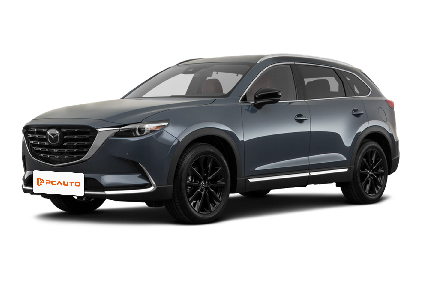Q
How many seats is the Mazda CX9 equipped with?
The Mazda CX-9 is a 7-seater midsize SUV featuring a 2+2+3 seating configuration. Those two individual second-row seats? Total game-changers for comfort, while the third row works perfectly for short hops or the kids. It’s a setup that just makes sense for big Malaysian families or anyone who regularly needs to move a crowd. Under the hood, you’ve got a 2.5-liter turbocharged petrol engine that’s got plenty of zip but won’t guzzle fuel – nice combo. Then there’s the solid suite of safety tech, things like adaptive cruise control and lane-keep assist, which really come in handy for those long drives we love taking here in Malaysia. Let’s not forget the interior, either – the materials feel premium, the overall vibe is super nice, and there’s a decent boot. Fold down the third row, and suddenly you’ve got way more cargo space, making it a breeze for everything from daily runs to weekend getaways. For Malaysian buyers, the CX-9 is a family SUV that nails the trifecta: practicality, comfort, and a bit of driving fun. Its roomy interior and flexible seating? Perfectly suited to our local roads and how we use our cars as families.
Special Disclaimer: This content is published by users and does not represent the views or position of PCauto.
Related Q&A
Q
Is the CX-9 fast?
The Mazda CX-9 is a large SUV with decent power performance in the Malaysian market. It's equipped with a 2.5-liter turbocharged engine, which outputs 227 horsepower and 420 Nm of torque. Paired with a 6-speed automatic transmission, the power output is smooth and sufficient to meet the needs of daily driving and high-speed overtaking. The 0 - 100 km/h acceleration takes about 8 seconds, which is relatively fast for a 7-seater family SUV. Although the acceleration performance of the CX-9 can't compare with that of performance SUVs, it's above average in its class. Especially, it has strong mid-range acceleration ability, making it suitable for driving on Malaysian highways. It's worth noting that the CX-9 uses Mazda's Skyactiv technology, which balances power and fuel economy. This is a good trade - off for Malaysian consumers. If you're after more powerful performance, you can consider some competitors with V6 engines. However, the CX-9 strikes a great balance between power, space, and fuel consumption, making it particularly suitable for Malaysian family users.
Q
How big is a CX-9 gas tank?
The fuel tank capacity of the Mazda CX-9 is 72.5 liters. This design can meet the needs of family long-distance trips, reducing the inconvenience of frequent refueling. For users in Malaysia, such a fuel tank size can provide good cruising range while taking fuel economy into account, which is especially practical when traveling across states or on self-driving tours. As a mid-to large-sized SUV, the CX-9 is equipped with an efficient power system. The fuel tank volume matches the fuel consumption performance of its 2.5-liter turbocharged engine, ensuring a reasonable driving range under comprehensive road conditions.
In addition, it is recommended that car owners regularly check the condition of the fuel tank and the oil circuit system and maintain good driving habits, such as smooth acceleration and reasonable use of cruise control, to further improve fuel efficiency. At the same time, pay attention to avoid exposing the fuel tank to the sun for a long time in Malaysia's hot climate, so as not to affect fuel evaporation and system safety.
Q
How many km per liter is a Mazda CX-9?
According to official data, the fuel economy of the Mazda CX 9 is roughly between 10 and 12 kilometers per liter of gasoline. The exact figure depends on driving conditions, road conditions, and vehicle configuration. For instance, the fuel consumption of the 2.5-liter turbocharged engine paired with a four-wheel-drive system is slightly higher than that of the front-wheel-drive version. In Malaysia, heavy traffic in the city may lead to higher fuel consumption, while driving on the highway can get closer to the ideal figure. Mazda's Skyactiv technology enhances fuel economy by optimizing engine efficiency and lightening the vehicle body, while maintaining power output. For consumers who are concerned about fuel consumption, it is recommended to regularly maintain tire pressure and engine condition and avoid aggressive driving. These habits can significantly affect the actual fuel-consumption performance. When compared with other SUVs in the same class, the CX-9's fuel consumption is at a medium level, but its handling and interior quality are still outstanding advantages, making it suitable for family users who pursue a great driving experience.
Q
How many kilometers can a Mazda CX-9 do?
As a mid-large SUV, the durability and mileage performance of the Mazda CX-9 mainly depend on daily maintenance and driving habits. Under normal use and regular maintenance, the CX-9 can reach a mileage of 200,000 to 300,000 kilometers or even more. Many owners have reported that the vehicle can maintain stable performance in the long run with good maintenance.
For users in Malaysia, the hot and humid climate may have a certain impact on vehicle components such as rubber seals and batteries. It is recommended to regularly check the cooling system and air-conditioning system, and replace the engine oil and filters according to the manufacturer's recommended maintenance schedule to extend the engine life.
The Skyactiv-G turbocharged engine equipped in the CX-9 has mature technology, and it performs well in terms of fuel economy and reliability, making it suitable for long-distance family trips. In addition, the rainy weather in Malaysia places certain requirements on the braking system and chassis anti-rust. It is recommended to regularly clean the chassis and check the thickness of the brake pads.
If you want to learn more about specific maintenance details, you can refer to the maintenance manual provided by Mazda Malaysia official or consult the authorized service center.
Q
What is the fuel consumption per 100km of the Mazda CX-9?
According to official data, the combined fuel consumption of the Mazda CX-9 in the Malaysian market is approximately 8.5 to 9.5 liters per 100 kilometers. The specific figure depends on driving habits, road conditions, and vehicle configuration. For example, the 2.5-liter turbocharged engine equipped in the vehicle has better fuel-consumption performance during high-speed cruising, while it will be slightly higher in congested urban areas. Malaysian car owners can refer to this data as a benchmark for their daily driving. At the same time, it is recommended to carry out regular vehicle maintenance, such as keeping the tire pressure normal and using the appropriate engine oil. These details can all help to optimize fuel economy.
In addition, Mazda's Skyactiv technology, with its efficient power system and lightweight design, provides ample power while also taking fuel-consumption performance into account. It is suitable for family users who value both the driving experience and practicality. If you have higher requirements for fuel consumption, you can also consider hybrid or pure-electric models. However, as a seven-seat SUV, the CX-9's fuel-consumption level is still competitive in its class.
Q
How long will a Mazda CX-9 last?
As a mid-large SUV designed mainly for family use, the Mazda CX-9 typically shows a durability of 150,000 to 200,000 kilometers or even more in the Malaysian market. The actual lifespan depends on the owner's maintenance habits and driving environment. Regularly changing engine oil, transmission fluid, maintaining the braking system and following the manufacturer's recommended maintenance schedule are the key factors. The hot and humid climate in Malaysia may have a certain impact on rubber components and electronic systems. It is recommended that car owners pay special attention to the inspection of the air-conditioning system and chassis parts.
The 2.5T turbocharged engine equipped in the CX-9 has mature technology and is paired with a 6-speed automatic transmission. The reliability of the powertrain has been verified by the market. However, for turbocharged models, more attention should be paid to the maintenance of the cooling system and intake system. When using this kind of large SUV in Malaysia, car owners also need to regularly clean the radiator to prevent overheating problems in the tropical climate, and choose regular gas stations to ensure fuel quality. If properly maintained, the CX-9 can fully meet the needs of Malaysian families for more than 10 years. Its relatively high resale value also reflects the market's recognition of its durability.
Q
What is the death rate of a Mazda CX-9?
Regarding the mortality data of the Mazda CX-9, the Malaysian official has not released the statistics on the traffic accident mortality rate of specific vehicle models. However, according to reports from multiple global safety evaluation institutions, the Mazda CX-9 performs excellently in terms of safety performance. For example, it has won the highest rating of "Top Safety Pick+" multiple times in the crash tests of the Insurance Institute for Highway Safety (IIHS) in the United States. This is due to its high-rigidity body structure, a well-developed airbag system, and advanced active safety technologies such as intelligent brake assist and lane-keeping assist.
For Malaysian consumers, when choosing an SUV, besides paying attention to safety ratings, they also need to consider local road conditions and driving habits. For instance, the G-Vectoring Control technology equipped in the CX-9 can improve handling stability on slippery roads. Regular maintenance and proper use of safety features (such as child seat interfaces) can further reduce risks.
It's worth noting that the mortality rate of any vehicle is closely related to factors such as driving behavior and road environment. Therefore, safety driving awareness and compliance with traffic rules are of crucial importance.
Q
Is CX-9 fuel efficient?
As a mid - large SUV, the Mazda CX-9 has above-average fuel efficiency among vehicles in the same class. The 2.5-liter turbocharged engine it's equipped with, combined with Skyactiv technology, not only provides sufficient power but also achieves relatively reasonable fuel consumption through optimized combustion efficiency and gearbox tuning. According to actual driving conditions, the combined fuel consumption is approximately 10 to 12 liters per 100 kilometers. For Malaysian users, although the fuel consumption of the CX-9 may be slightly higher than that of compact SUVs, considering its spacious interior and strong power output, such performance is still acceptable. If you focus more on fuel economy, you can consider hybrid models or diesel versions. However, the balance between performance and practicality of the CX-9 is still worth considering. Especially during family trips or long-distance drives, its comfort and safety can also offer a great experience.
Q
Do Mazda CX-9 hold their value?
The Mazda CX - 9's performance in terms of value retention in the Malaysian used-car market is above average. Its resale value is influenced by the brand's reputation, the vehicle's model positioning, and market demand. As an imported seven-seat SUV, the CX-9 has gained stable recognition among local middle-and high-end family users thanks to its KODO design language, SKYACTIV technology, and luxurious interior configuration. In particular, the post-2017 facelifted models are more popular as they have upgraded safety features like the i-ACTIVSENSE system.
However, its resale value is slightly lower than that of non-luxury brand hardcore SUVs such as the Toyota Fortuner. This is mainly because the latter has a larger market presence in Southeast Asia and lower maintenance costs. Nevertheless, the CX-9 can still maintain a relatively stable used-car price due to its more refined design and driving experience. Typically, a three-year-old CX-9 can retain about 60-65% of its original value.
It's worth noting that Malaysian consumers generally pay close attention to the maintenance records and original warranty status when purchasing a used CX-9. It is recommended to give priority to vehicles serviced at Mazda-authorized dealerships to safeguard their subsequent resale value. At the same time, one should be aware of the longer supply cycle of imported car parts. Regular maintenance and complete repair records can significantly increase the premium of a used car.
Q
Which country made Mazda CX-9?
The Mazda CX-9 is an SUV model designed and produced by the Japanese automaker Mazda. It is mainly targeted at the global market, including Malaysia. This vehicle is manufactured at Mazda's factory in Hiroshima, Japan, and it adopts the brand's latest KODO design language and Skyactiv technology, emphasizing the combination of a dynamic exterior and efficient power performance.
The CX-9 is quite popular in the Malaysian market. Thanks to its spacious three - row seat layout and luxurious interior configuration, it is suitable for family users. As a Japanese brand, Mazda has always focused on the driving experience and fuel economy. The 2.5-liter turbocharged engine equipped in the CX-9 not only provides ample power but also takes environmental protection performance into account.
For Malaysian consumers, the CX-9 is an imported SUV that combines practicality and brand reputation. Its Japanese manufacturing background also adds a guarantee of quality. Meanwhile, Mazda has a relatively complete dealer network and after-sales service system in Malaysia, which makes it convenient for car owners to carry out maintenance.
Popular Cars
Model Year
Car Compare
Car Photo
Latest Q&A
Q
What does engine capacity refer to?
Engine Capacity refers to the total volume of all cylinders inside the engine, usually expressed in cubic centimeters (cc) or liters (L), such as 1.5L or 1500cc, It directly reflects the total amount of air and fuel mixture that the engine can inhale and compress in a complete cycle. A larger engine capacity usually means higher power output because more fuel and air participate in combustion, producing stronger explosive force to push the piston. However, engine capacity is not the only factor determining performance. Turbocharging, fuel injection technology, etc. can also allow small displacement engines to perform close to or even better than large displacement engines. In addition, engine capacity also affects fuel consumption and road taxes. Although large displacement engines have abundant power, their fuel consumption is relatively high, and they may need to pay higher annual road taxes, while small displacement engines are more economical and suitable for daily commuting. When choosing a vehicle, You can balance the relationship between engine capacity and fuel economy according to your driving needs.
Q
How do I find engine capacity?
To find your vehicle's engine capacity, the easiest ways are to check the owner's manual or the engine bay sticker – you'll usually see it clearly marked as something like 1.5L or 2.0T. Another option is to look at your vehicle registration card (Geran) or check the JPJ website for detailed specs, where the engine size will be listed.
Engine capacity is measured in liters (L) or cubic centimeters (cc), with 1.0L equaling 1000cc. It tells you the total volume of all cylinders and gives a rough idea of power and fuel efficiency. Generally, bigger engines deliver more power but may drink more fuel.
That said, performance isn't just about size – tech like turbocharging and fuel injection also plays a big role. If you're mainly commuting, a smaller engine could be the smarter pick, while drivers who want more punch might prefer a larger or turbocharged setup.
Still unsure? Your best bet is to call an authorized service center for the exact specs.
Q
How many cc is a 1.2 litre engine?
A 1.2L engine has a displacement of 1,200cc—since one liter equals 1,000 cubic centimeters (cc), simple math does the trick. Engine displacement measures the total swept volume of all cylinders, serving as a key indicator of power output. Generally, bigger displacement means more muscle, though at the cost of higher fuel consumption.
In our market, 1.2L engines are commonly found in budget-friendly compact cars, striking a solid balance between fuel efficiency and adequate pep for city driving. But here’s the catch: While displacement matters, real-world performance hinges on engineering tricks like turbocharging or direct injection—tech that can squeeze extra power from small engines while keeping thirst for fuel in check.
If fuel economy tops your checklist, a 1.2L powertrain deserves a look—just don’t skip the test drive. Numbers tell part of the story; how it *feels* on the road tells the rest.
Q
How many cc is a V8 engine?
The displacement (cc) of a V8 engine isn't a fixed number—it varies based on the vehicle model and manufacturer's design. Typically, you'll find them ranging between 4.0L and 6.2L, which translates to roughly 4000cc to 6200cc. Classic American muscle cars, for example, often pack a 6.2L (6200cc) V8, while some high-performance sports cars or luxury models might use a smaller 4.0L (4000cc) turbocharged V8.
Thanks to its symmetrical eight-cylinder layout, a V8 delivers both raw power and smooth acceleration, making it a favorite for drivers who crave performance or that big-displacement thrill. But remember, displacement isn't the only factor in power output. Modern tech like turbocharging, direct injection, and variable valve timing can squeeze out more efficiency and horsepower from even a smaller V8.
With tighter emissions regulations, many automakers are now exploring hybrid systems or downsized V8s to balance performance and eco-friendliness. Going forward, V8 development will likely focus more on tech upgrades than just upping displacement.
Q
What is the best engine capacity?
Choosing the right engine displacement depends on your personal needs and driving habits. Generally, a 1.5L to 2.0L engine strikes a good balance between power, fuel efficiency, and maintenance costs—making it ideal for daily commutes and family use. These engines are tried-and-true, easy to service, and relatively economical on fuel.
If you frequently take long trips or crave stronger performance, engines above 2.0L deliver better acceleration and highway stability, though at the cost of higher fuel consumption and road tax. Meanwhile, small turbocharged engines (like 1.0L or 1.2L turbos) have gained popularity in recent years. They offer near-equal punch to larger engines while sipping less fuel and keeping tax bills low—perfect for city driving or budget-conscious buyers.
Hybrids and EVs, on the other hand, sidestep traditional displacement concerns altogether, relying on electric motors for efficiency. As tech evolves, raw displacement may matter less than overall energy effectiveness in the long run.
View MoreRelated News

Rumor: Toyota and Mazda collaborate to develop the next-generation MX-5 and GR86
AshleySep 30, 2025

MAZDA EZ-60 will be launched in China, and will be available in other global markets in 2026
RobertSep 30, 2025

CX-80 too large? Too expensive? Mazda also offers you the CX-60
WilliamSep 4, 2025

Mazda Malaysia Launches its Largest SUV, the CX-80, with a Price of RM331,610
Kevin WongSep 4, 2025

Mazda Australia stated that there are currently no plans to launch an electric version of the BT-50.
LienAug 28, 2025
View More


















Pros
Cons